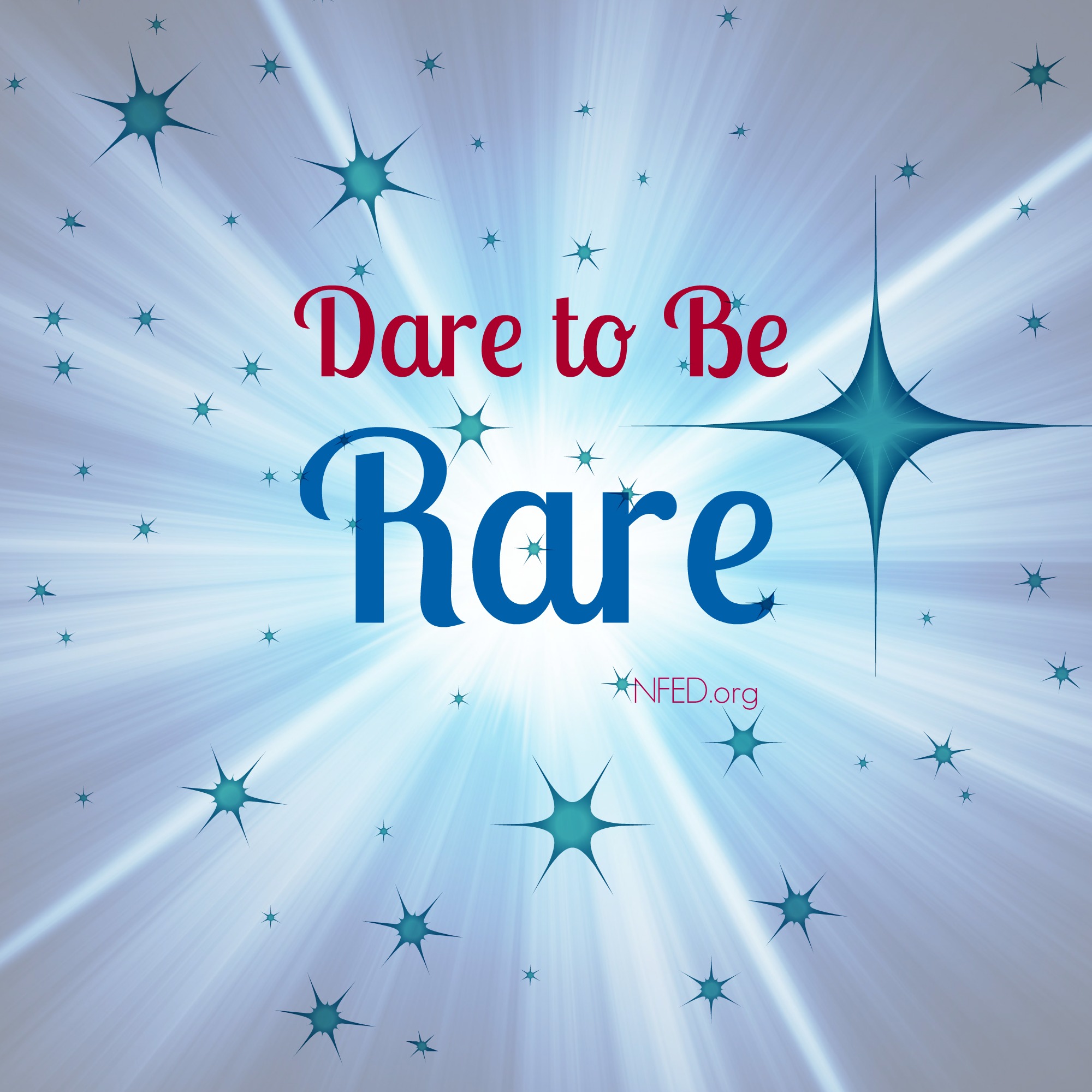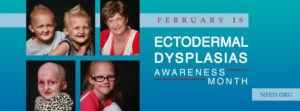
All of the 180+ different types of ectodermal dysplasias are considered “rare” because they affect less than 200,000 people in the United States. But some of the syndromes are much more rare than others. Here is a sampling of 10 that fall into that latter category.
Book’s Syndrome – 1 person
Signs and symptoms include failure of premolars to develop; excessive sweating; and premature graying of the hair.
Coffin-Siris’s Syndrome – 1 person
Coffin-Siris syndrome is a condition that affects several body systems. Although there are many variable signs and symptoms, hallmarks of this condition include developmental disability, abnormalities of the fifth (pinky) fingers or toes, and characteristic facial features. Most affected individuals have mild to severe intellectual disability or delayed development of speech and motor skills such as sitting and walking.
Underdevelopment of the tips of the fingers or toes, or hypoplasia or absence of the nails also occurs. Most affected individuals have facial features described as coarse. These typically include a wide nose with a flat nasal bridge, a wide mouth with thick lips, and thick eyebrows and eyelashes. Affected individuals can have excess hair on other parts of the face and body, but scalp hair is often sparse. There is a range of facial features seen in people with Coffin-Siris syndrome, and not all affected individuals have the typical features. In addition, people with this condition may have an abnormally small head.
Cranioectodermal Dysplasia – 1 person
Cranioectodermal dysplasia affects many parts of the body. The most common features involve bone abnormalities and abnormal development of certain tissues known as ectodermal tissues, which include the skin, hair, nails, and teeth. Distinctive abnormalities of the skull and face are common in people with cranioectodermal dysplasia. Most affected individuals have a prominent forehead and an elongated head due to abnormal fusion of certain skull bones.
A variety of facial abnormalities can occur in people with this condition; these include low-set ears that may also be rotated backward, an increased distance between the inner corners of the eyes, and outside corners of the eyes that point upward or downward among others. Development of bones in the rest of the skeleton is also affected in this condition. Abnormal development of ectodermal tissues in people with cranioectodermal dysplasia can lead to sparse hair, small or missing teeth, short fingernails and toenails, and loose skin. It can affect additional organs and tissues in the body and include abnormalities of the liver, heart, or eyes.
Hypomelanosis of Ito – 1 person
Hypomelanosis of Ito is a rare condition characterized by distinctive skin changes, in which areas of the body lack skin color. These skin changes may present as patches, streaks or spiral-shaped areas. There are a wide variety of symptoms potentially associated with hypomelanosis of Ito. Neurological findings such as seizures and developmental delays and musculoskeletal symptoms such as abnormal curvature of the spine are commonly associated with this condition.
Because of the neurological and skin symptoms, hypomelanosis of Ito may be referred to as a “neurocutaneous” syndrome. However, in many cases the condition arises from genetic irregularities that are present in some cells of the body, but not in others. Some researchers believe that hypomelanosis of Ito does not represent a distinct disorder but rather a symptom common to a group of disorders involving genetic mosaicism.
Trichodental Dysplasia – 1 person
Trichodental dysplasia includes missing teeth, peg-shaped incisors, and shell teeth. The hair is fine, sparse, dull, and slow growing. Mild microcephaly and mental retardation may occur.
GAPO – 1 person
The GAPO syndrome is a rare but distinct genetic disorder. GAPO is an acronym for the manifestation of growth retardation, alopecia, pseudoanodontia and optic atrophy. Symptoms of GAPO affect the hair, teeth, eyes, skin, and face. Specifically, GAPO syndrome is characterized by reduced birth length, alopecia (hair loss from the scalp or body), failure of the teeth to erupt from the gums, and loss of some or all of the fibers of the optic nerve, a condition known as optic atrophy. The optic nerve carries visual information from the eye to the occipital lobe in the brain, which then processes the information. In addition, physical growth is delayed. Symptoms such as reduced birth length can be observed at birth
Gorlin-Chaudhry-Moss’ Syndrome (Gorlin’s Syndrome) – 1 person
GCM is characterized by premature closure of the fibrous joints, or sutures, between certain bones in the skull, unusually small eyes, absence of some teeth, and excessive amounts of hair) on most areas of the body. In addition, growth retardation, short fingers and toes, and underdevelopment of the two long folds of skin on either side of the vaginal opening in females can occur.
There may be an abnormal opening between the two large blood vessels that carry blood away from the heart which can cause patent ductus arteriosus, an inappropriate recirculation of some blood through the lungs, rather than throughout the rest of the body. Some people with GCM may have delayed growth and hearing loss. Some may have mild intellectual disabilities, while others may be of normal intelligence.
Johanson-Blizzard’s Syndrome – 1 person
Johanson-Blizzard syndrome (JBS) is an extremely rare genetic disorder that affects multiple organ systems of the body. Many symptoms are present at birth (congenital) or early childhood. The spectrum of potential features and physical findings associated with JBS is wide and varied and can differ dramatically from one person to another. Characteristic features include insufficient intestinal absorption of fats and other nutrients due to abnormal development of the pancreas; failure to thrive during the first years of life, contributing to short stature; abnormalities of permanent teeth; distinctive abnormalities of the skull and facial region including a small “beak-shaped” nose; and/or varying degrees of intellectual disability.
Odontoonychodermal Dysplasia Syndrome – 1 person
Symptoms include dystrophic nails, misshapen teeth, including peg-shaped incisors, and erythematous lesions of face and thickening of the palms and soles which showed hyperhidrosis. The hair can be unaffected or dry and sparse with thinning of the eyebrows.
Papillion-Lefevre’s Syndrome – 1 person
Papillon-Lefèvre Syndrome (PLS) is an extremely rare genetic disorder that typically becomes apparent from approximately one to five years of age. PLS is characterized by the development of dry scaly patches on the skin of the palms and the soles, in association with severe inflammation and degeneration of the structures surrounding and supporting the teeth. The primary teeth frequently become loose and fall out by about age five. Without treatment, most of the secondary teeth may also be lost by approximately age 17. Additional symptoms and findings associated with PLS may include frequent pus-producing skin infections, abnormalities of the nails, and excessive perspiration.
* The numbers of people affected are taken from the NFED database and not based on medical literature. Like all ectodermal dysplasias, we are confident that more people are affected by these types. However, they are not in touch with the NFED.

I have 2 sons with 16 missing adult teeth and one son with normal teeth development. The first son is now in the process of trying to get dental implants. I have not insurance dental yet but am sure it is coming. Do you have suggestions on best way to appeal?
Hi, Christine! Thanks for reaching out. We have a lot of information on navigating the insurance process available on our website. My best recommendation would be to start here: https://nfed.org/treat/insurance-assistance-program/. If you have further questions, please let us know! Also, if you are in the U.S., please join our efforts to advocate for the Ensuring Lasting Smiles Act (ELSA), which will help ensure private, individual and group plans cover medically necessary treatments such as these. You can learn more about ELSA here: https://nfed.org/get-involved/advocate/.
Best,
Veronica